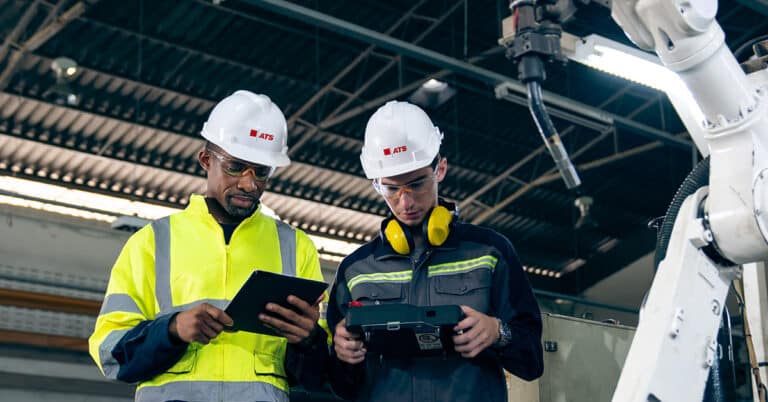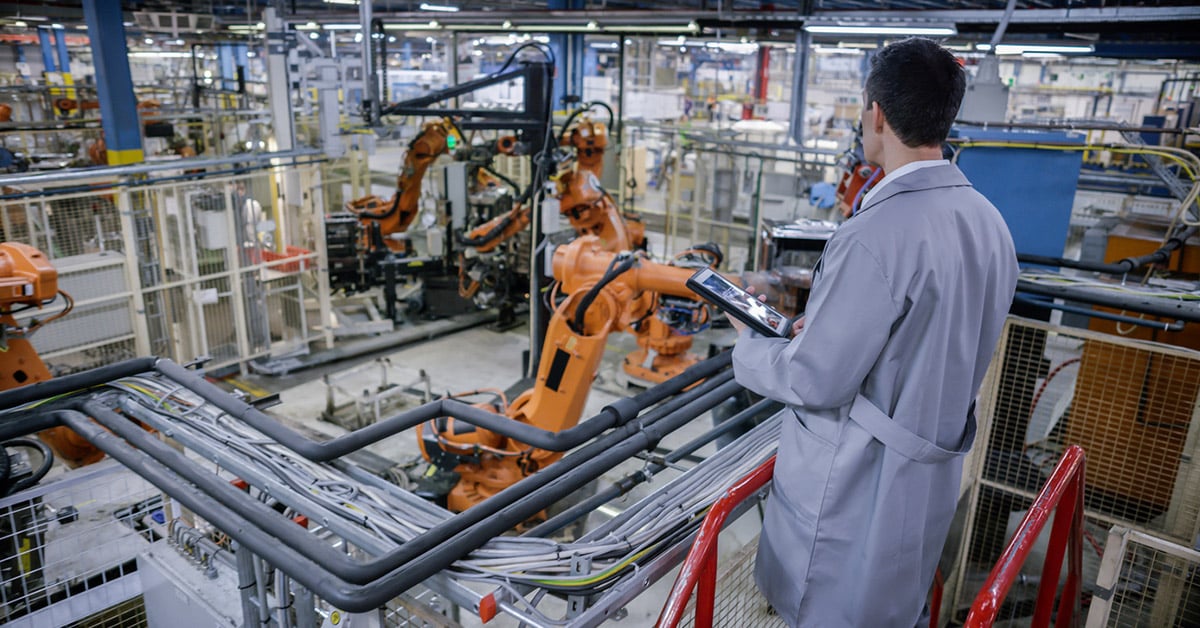The role of artificial intelligence in manufacturing is continually growing today, based on a number of factors, including:
- Increased availability of technology
- Ever tighter profit margins
- The need for manufacturers to remain competitive in their space
AI in manufacturing yields a broad range of benefits, which we will discuss throughout this article in greater depth. More manufacturers than ever are drawing upon AI in production and other areas of the manufacturing process, taking advantage of technology that is more accessible than ever while understanding the need to keep pace with competitors and innovators who are setting today’s bar with the adoption of AI tools.
Read on to see how the impact of AI in manufacturing industry applications is changing the face of the sector and yielding vast productivity and bottom-line benefits for manufacturing organizations.
Trends with AI in the manufacturing industry
AI in manufacturing sector applications is growing at a rapid pace, bolstered by the dropping cost of AI technology implementation and the increasing realization among manufacturers that artificial intelligence is one of the most effective ways to increase productivity and retain a competitive edge. In fact, according to an MIT study conducted by the Sloan School of Management, 26% of companies are using AI in widespread production — more than doubling the previous year’s 12% figure. And perhaps most importantly, 92% of large manufacturers have seen a positive ROI on their data and AI investments.
While it is always difficult to be an “early adopter” for technology, these figures prove that AI in manufacturing is likely here to stay, thanks to the significant cost and productivity benefits that it is providing for the businesses that have made the investment.
Uses of AI in manufacturing
The role of AI in manufacturing extends to numerous areas and applications. These include:
- Machine maintenance: AI can make a major impact on maintenance processes throughout the organization, and AI in predictive maintenance is likely the area that can yield the greatest benefit. Condition Monitoring — the practice of drawing upon data from maintenance sensors in order to identify potential problem states for equipment as early as possible — has seen immense impacts from AI, analyzing data in innovative ways to not only detect potential issues even earlier, but also to help identify new troubleshooting scenarios and metrics.
- Quality control: AI in factories is not limited to the production process itself. Artificial intelligence can also help during the quality control process, casting a consistent and untiring virtual “eye” over every piece of output and increasing the rate of defect detection.
- Workplace safety: AI boosts workplace safety in several ways. With collaborative robotic technology, automated equipment and human workers can work side by side safely, with AI able to detect and address potential safety risks. AI also aids in safety by improving training processes and, through augmented reality, allowing new hires to gain the equivalent of hands-on experience without risking either personal safety or production efficiency.
- Machine vision: With AI, machine vision processes — sorting, inspection, security and QC — can be increasingly automated and can become increasingly accurate. AI can support human workers in increasing the speed of these processes and helping to call out potential issues for further investigation, all while improving throughput and quality.
- Inventory management: Inventory management is one of the areas of manufacturing that is most ripe for digital transformation, and artificial intelligence is making a major impact here. AI can aid in industrial asset management, applying automation to sourcing, supply chain management, storeroom management and other key areas of inventory that can make a significant impact on spending.
- Cybersecurity: With the advent of the connected facility, cybersecurity has become a major concern. Artificial intelligence helps maintain a secure network implementation by identifying potential vulnerabilities or attacks before they can bloom into more significant issues, drawing on historical data and real-time network monitoring.
- Robotics: AI helps power today’s advanced automation systems. Artificial intelligence can help robotic systems become even more efficient by identifying potential bottlenecks and adjusting automatically to prevent slowdowns. AI also can collect information from robotic equipment in real time and make suggestions for improving performance.
- Factory Automation: By taking a close look at available data, AI can develop plans for improvements throughout a production facility. This can save a significant amount of time because AI can process information much faster and more efficiently, giving people more time to concentrate on other areas.
- Product Design: The use of AI in developing new products means manufacturers can test their designs in a virtual environment before creating a prototype. AI simulations can provide valuable information about the feasibility of a design without taking up as much time as a real-world test. It also may give design teams the opportunity to discover numerous design options they may not have been able to think of otherwise. In more-advanced applications, designers may be able to input materials, measurements and other basic parameters for a product and return multiple iterations of that product to improve upon the original concept.
Benefits of AI in manufacturing

AI in manufacturing offers numerous benefits, including:
Data collection & data-informed decisions
Connected facilities collect vast amounts of data throughout every cycle, every day. AI in factories helps to make sense of this data and facilitate informed, data-driven decisions that can make a major impact on productivity, uptime and the bottom line. In conjunction with data scientists and other personnel who are equipped to understand the data provided by industrial sensors, AI can help make quicker and more effective decisions.
Increased production
Some of the primary benefits of AI in manufacturing include more effective maintenance, improved decision-making and, ultimately, more uptime. With equipment running at full capacity more often, production throughput will naturally increase, yielding higher output and better quality.
Optimize process effectiveness
Supported by the data collected from industrial sensors, AI helps to eliminate unplanned downtime and optimize process effectiveness. With AI examining equipment performance data, not only are impending maintenance issues detected, but potential inefficiencies are identified as well. This helps to fine-tune equipment to ensure optimal operation and maximum output at peak quality.
Reduce operational costs
AI in manufacturing and maintenance boosts efficiency and reduces costs in numerous ways. With AI-assisted data analysis, maintenance technicians can make more accurate assessments more quickly than before, helping to reduce or eliminate downtime, keep equipment running at peak performance, and get equipment back online more quickly if a shutdown does occur. AI can also ease QC resource burdens and other areas.
Safer facilities
Aside from the obvious impacts on employee health and well-being, safety issues can also negatively impact workplace morale. AI helps to keep employees out of harm’s way, enabling automation and robotics to take over the most hazardous of the processes in the manufacturing facility. AI and augmented reality can also positively impact safety by creating more effective training processes.
AI implementation process
Before moving forward with AI implementation, there are considerations and steps that are required along the way in order to have AI work in harmony with the production side of the facility. The following basic steps will help you understand how to get started with an AI strategy:
- Diagnosis: While AI has an extremely extensive and diverse list of applications, it is far from a one-size-fits-all solution. Furthermore, while AI can certainly impact nearly every area of production and operations, in an initial implementation, you should target a few — or even just one — high-impact areas. This stage involves identifying the areas that could most benefit from an AI implementation.
- Create a working proof of concept: In this stage, AI technicians will design an AI system and create a working proof of concept for implementation.
- Pilot system: Piloting the system involves preliminary testing, ensuring that the system operates as expected and does not create any unexpected problems with production. Once these high-level tests are completed, you are ready to move to the next stage.
- Co-create: In this step, technicians are making improvements in tandem with the AI, optimizing and tweaking parameters as needed.
- Self-create: This stage enables the AI to work independently, drawing on data and parameters to improve and fine-tune on its own. The intent at this stage is that technicians will monitor the progress of the AI but will have little to no input as it continues to develop and improve.
Challenges of AI implementation
AI implementation does present several challenges before realizing the benefits described above. These include:
- Cost of adoption: While technology costs continue to lower, AI systems still entail a significant investment to get up and running. Even in the face of proven positive ROI, the cost of entry can prove to be a barrier for some organizations.
- Need for skilled experts: In addition to hardware and infrastructure, AI also requires skilled technology experts to build and operate systems, analyze data and ensure that the implementation is operating as intended. While AI can introduce massive efficiencies in operations, it still needs skilled people to run it.
- Data quality and system obsolescence: In order to operate effectively, AI needs up-to-date sensors and system software. Even if organizations have begun to implement industrial sensors, they may need to update hardware or software for compatibility with AI technology.
AI expectations
It is important to establish proper expectations for an AI implementation, especially in light of the significant time and resource investment required to get a system up and running. Most important is to view AI as a long-term solution, where the proper foundation can be iterated upon to yield massive benefits over forthcoming years. While AI adoption is on the rise, it is still a relatively new technology, and one for which the full potential is still being developed.
ATS is a leading maintenance technology implementation partner, delivering decades of experience in helping manufacturers stay on the cutting edge of cost-saving maintenance tactics. Our services and expertise cover industrial maintenance solutions, along with industrial technology focused on condition monitoring for reliability excellence. To learn how we can help apply our results-focused strategy to your operations, contact us today.


